Embrace eco-friendly tea rituals to elevate your sipping experience. Start by composting spent tea leaves to nourish your garden. Try solar-powered brewing for a unique, sustainable steep. Switch to reusable tea bags or infusers to reduce waste. Explore loose leaf teas for enhanced flavor and less packaging. Transform empty tea tins into charming mini planters. Practice zero-waste ceremonies by mindfully choosing each element. Source your teas thoughtfully, prioritizing organic and fair trade options. These seven rituals not only minimize your environmental impact but also deepen your connection to the tea-drinking process. Discover how each practice can transform your daily brew into a mindful, earth-conscious ritual.
Composting Spent Tea Leaves
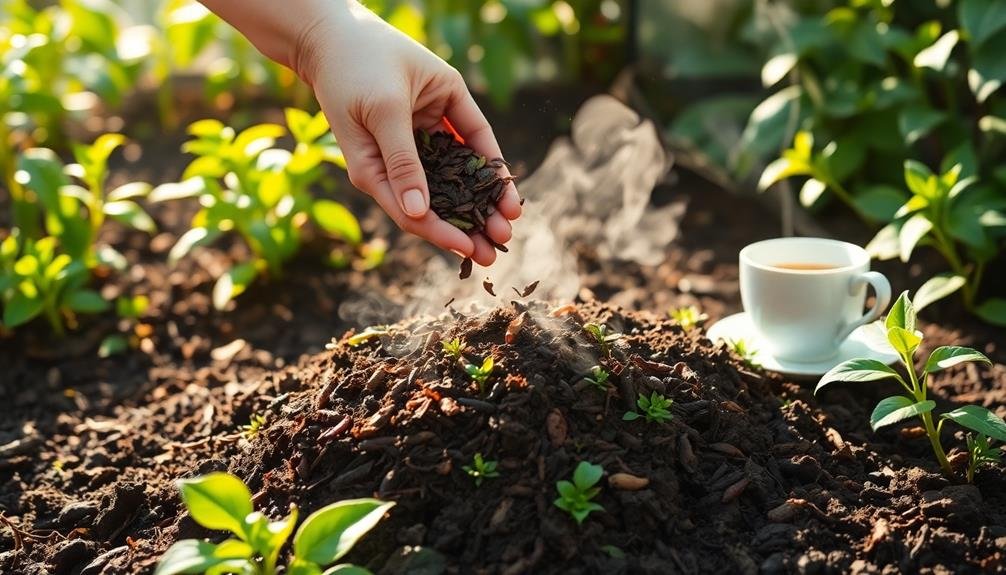
When you're done savoring your cup of tea, don't toss those spent leaves in the trash! Instead, add them to your compost bin or garden.
Tea leaves are rich in nitrogen, making them an excellent "green" component for composting. They'll break down quickly, enriching your soil with valuable nutrients.
If you don't have a compost bin, you can still put those tea leaves to good use. Sprinkle them directly around your plants as a natural fertilizer. They'll help retain moisture in the soil and deter pests.
For indoor plants, mix dried tea leaves into the potting soil to improve drainage and aeration.
You can also use spent tea leaves to create a nutrient-rich "tea" for your plants. Steep the used leaves in water overnight, then strain and use the liquid to water your garden.
This homemade fertilizer is particularly beneficial for acid-loving plants like roses and ferns.
Solar-Powered Tea Brewing
You can harness the power of the sun to brew your tea, reducing your carbon footprint while enjoying a perfect cup.
Consider investing in solar-powered kettles or using glass jars to create sun tea, both of which offer eco-friendly alternatives to traditional brewing methods.
For ideal results, choose bright, sunny days when the temperature is warm enough to effectively steep your favorite blend.
Harnessing Sunlight for Steeping
Harnessing the sun's energy to brew tea offers a sustainable and eco-friendly alternative to traditional methods. You'll find that solar-powered steeping not only reduces your carbon footprint but also infuses your tea with a unique flavor profile.
To begin, you'll need a clear glass container and ample sunlight. Fill the container with cold water and add your chosen tea leaves or bags. Place it in direct sunlight for several hours, allowing the sun's rays to slowly heat the water and extract the tea's flavors.
The process typically takes 3-5 hours, depending on the intensity of sunlight and desired strength. You can experiment with different tea varieties to discover which ones work best with this method. Green and white teas often produce excellent results, as their delicate flavors are preserved by the gentle heating process.
For a revitalizing twist, try adding fresh herbs or fruit slices to your solar-brewed tea. Once it's ready, strain the tea and serve it over ice for a cool, environmentally conscious beverage.
Remember to adjust steeping times based on your location's climate and seasonal variations in sunlight intensity.
Eco-Friendly Equipment Options
While solar-powered tea brewing can be accomplished with simple household items, specialized eco-friendly equipment can enhance your experience and results.
Consider investing in a solar tea maker, which uses a clear glass or BPA-free plastic container with a built-in infuser. These devices often feature a wide mouth for easy cleaning and a spout for convenient pouring.
For on-the-go brewing, try a portable solar tea tumbler. These innovative products have a clear outer chamber that allows sunlight to penetrate, warming the inner chamber where your tea steeps. Some models even include a solar-powered temperature display.
If you're looking for a more traditional approach, opt for a handcrafted ceramic teapot with a cork or wooden lid. These materials are biodegradable and provide excellent insulation for your sun-brewed tea.
Pair it with reusable cotton tea bags or a stainless steel infuser to minimize waste.
Don't forget about your cup! Choose eco-friendly options like bamboo, recycled glass, or biodegradable plant-based materials.
These alternatives not only reduce your environmental impact but also add a unique aesthetic to your tea ritual.
Optimal Weather Conditions
Success in solar-powered tea brewing hinges on ideal weather conditions. You'll want to choose clear, sunny days with minimal cloud cover to maximize solar energy absorption. Aim for temperatures above 70°F (21°C) for best results, as warmer ambient temperatures help maintain the water's heat during the brewing process.
The best time for solar tea brewing is typically between 10 AM and 2 PM when the sun's rays are strongest. Position your solar tea maker or jar in a spot that receives direct sunlight throughout this period. South-facing locations often work well in the Northern Hemisphere.
Wind can be both a friend and foe in solar tea brewing. A gentle breeze can help prevent overheating, but strong winds may cool your brew too quickly. If it's windy, consider using a windbreak or placing your tea maker in a sheltered area.
Humidity levels also play a role. In drier climates, your tea may evaporate more quickly, so you might need to adjust your brewing time or water quantity. Conversely, in humid environments, condensation can form inside your container, potentially diluting your brew.
Reusable Tea Bags
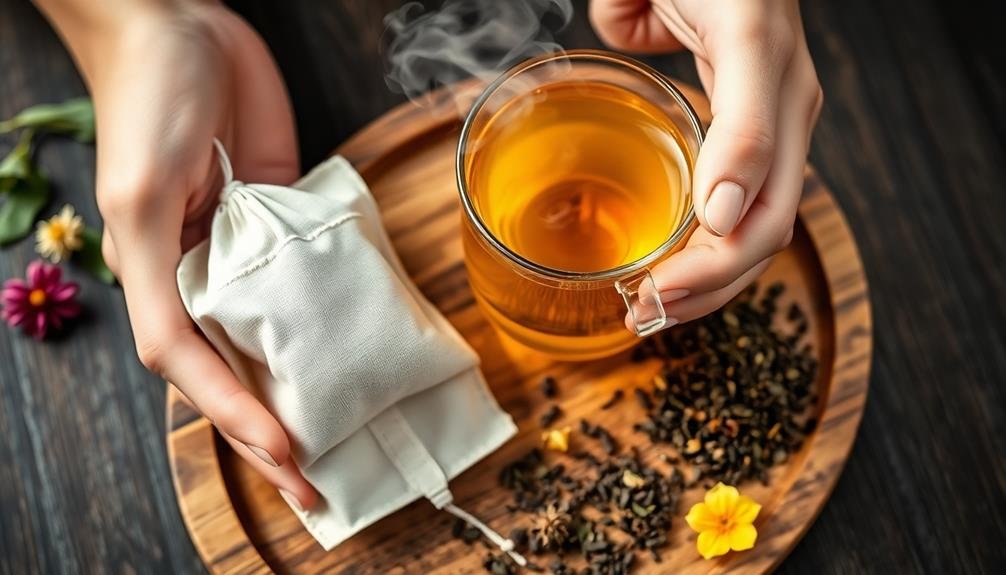
You'll find various types of reusable tea bags on the market, including cotton, muslin, and stainless steel mesh options.
To keep your reusable bags in top condition, rinse them thoroughly after each use and periodically deep clean them with boiling water or a mild detergent.
Types of Reusable Bags
Sustainability meets tradition in the world of reusable tea bags. You'll find a variety of options to suit your brewing preferences and eco-conscious lifestyle.
Cloth tea bags, often made from organic cotton or hemp, are popular choices. They're durable, easy to clean, and allow excellent water flow for ideal infusion.
Silicone tea bags offer a non-porous, heat-resistant alternative that's dishwasher-safe and long-lasting.
For a more traditional feel, you might opt for stainless steel mesh infusers. These come in various shapes, from balls and baskets to spoons and clips, providing versatility for different cup sizes.
If you're looking for a biodegradable option, consider bags made from corn fiber or other plant-based materials. They'll break down naturally after multiple uses.
Paper filters made from unbleached, compostable materials are another eco-friendly choice. While not indefinitely reusable, they can be composted after several uses.
For loose leaf enthusiasts, tea socks – long, cylindrical bags made from muslin or cotton – offer ample space for leaves to expand.
Whichever type you choose, you're taking a step towards reducing waste and enhancing your tea ritual.
Cleaning and Maintenance Tips
Proper care of your reusable tea bags guarantees their longevity and maintains the purity of your brew. After each use, rinse your tea bag thoroughly with warm water to remove any tea residue.
For a deeper clean, soak it in a mixture of warm water and mild dish soap for about 15 minutes. Gently scrub the bag with a soft brush to remove any stubborn stains or odors.
If you're using cloth tea bags, you can machine wash them on a gentle cycle with cold water. Avoid using harsh detergents or fabric softeners, as these can affect the taste of your tea.
For more delicate materials like silk or muslin, hand washing is recommended.
To dry your reusable tea bags, squeeze out excess water and hang them in a well-ventilated area. Avoid direct sunlight, which can cause fading or weakening of the material.
Once completely dry, store your tea bags in a clean, dry container to prevent contamination.
Regularly inspect your tea bags for signs of wear and tear. Replace them if you notice any holes or fraying to guarantee ideal brewing and prevent loose tea leaves from escaping into your cup.
Benefits Over Disposables
Beyond the obvious environmental benefits, reusable tea bags offer numerous advantages over their disposable counterparts.
You'll enjoy a more authentic tea experience, as these bags allow for better water circulation and expansion of tea leaves. This results in a fuller, richer flavor that you simply can't achieve with disposable bags.
You'll also save money in the long run. While the initial investment may be higher, reusable bags quickly pay for themselves as you'll no longer need to constantly purchase disposable ones.
Plus, you'll have the flexibility to use loose leaf teas, which are often more affordable and of higher quality than pre-packaged options.
Reusable bags give you control over the tea-to-water ratio, allowing you to customize the strength of your brew.
They're also versatile, accommodating various tea types and blends. You can even use them for brewing herbs, spices, or creating your own unique infusions.
Lastly, you'll reduce your exposure to potentially harmful chemicals found in some disposable tea bags, such as plastics and bleaching agents, ensuring a purer, healthier cup of tea.
Loose Leaf Tea Practices
When it comes to earth-friendly tea rituals, embracing loose leaf tea practices is a game-changer. You'll find that loose leaf tea not only reduces packaging waste but also offers a superior flavor experience.
Start by investing in a reusable tea infuser or strainer, which allows you to brew your tea without disposable bags. These come in various styles, from metal mesh balls to silicone tea eggs.
To brew, simply measure your desired amount of loose tea into the infuser and steep in hot water. You'll notice the leaves unfurl and release their full flavor, unlike the limited expansion in tea bags.
After brewing, empty the used leaves into your compost bin or garden – they're excellent for nourishing plants.
Don't forget to store your loose leaf tea properly in airtight containers away from light and moisture. This preserves freshness and flavor, ensuring you get the most out of your eco-friendly choice.
Upcycled Tea Container Gardens

Another creative way to make your tea ritual more eco-friendly is by creating upcycled tea container gardens. Instead of discarding empty tea tins or boxes, repurpose them as charming mini planters. These containers often have appealing designs that can add character to your home or office.
Start by cleaning the container thoroughly and punching drainage holes in the bottom. Fill it with potting soil and choose plants that thrive in small spaces, such as succulents, herbs, or small flowers. Mint, thyme, and chamomile are excellent choices that complement your tea ritual.
You can create themed gardens based on your favorite teas. For example, use an Earl Grey tin to grow lavender, or plant lemongrass in a green tea container. These mini gardens not only reduce waste but also provide fresh herbs for your brews.
Display your upcycled tea gardens on windowsills, shelves, or as centerpieces. They'll serve as reminders of your commitment to sustainability and add a touch of nature to your tea-drinking experience.
Plus, tending to these tiny gardens can become a mindful practice in itself, enhancing your overall tea ritual.
Zero-Waste Tea Ceremonies
Zero-waste tea ceremonies embrace the essence of mindfulness and environmental stewardship. By incorporating sustainable practices into your tea ritual, you'll create a more eco-conscious experience while deepening your connection to the tea and its origins.
Start by selecting loose-leaf teas to reduce packaging waste. Use reusable filters or infusers instead of disposable tea bags. Opt for a ceramic or glass teapot that's durable and long-lasting. Choose cloth napkins and reusable cups to eliminate paper waste.
Consider these zero-waste elements for your tea ceremony:
| Preparation | Serving | Cleanup |
|---|---|---|
| Loose-leaf tea | Ceramic teapot | Compostable leaves |
| Reusable filter | Glass cups | Cloth napkins |
| Electric kettle | Bamboo tray | Reusable towels |
| Natural sweeteners | Wooden utensils | Natural cleaners |
| Fresh herbs | Cloth coasters | Upcycled decorations |
After your ceremony, compost the used tea leaves and any herb remnants. Clean your teaware with natural, biodegradable soaps. By mindfully considering each aspect of your tea ritual, you'll create a zero-waste experience that honors both the tea tradition and the environment.
Mindful Tea Sourcing
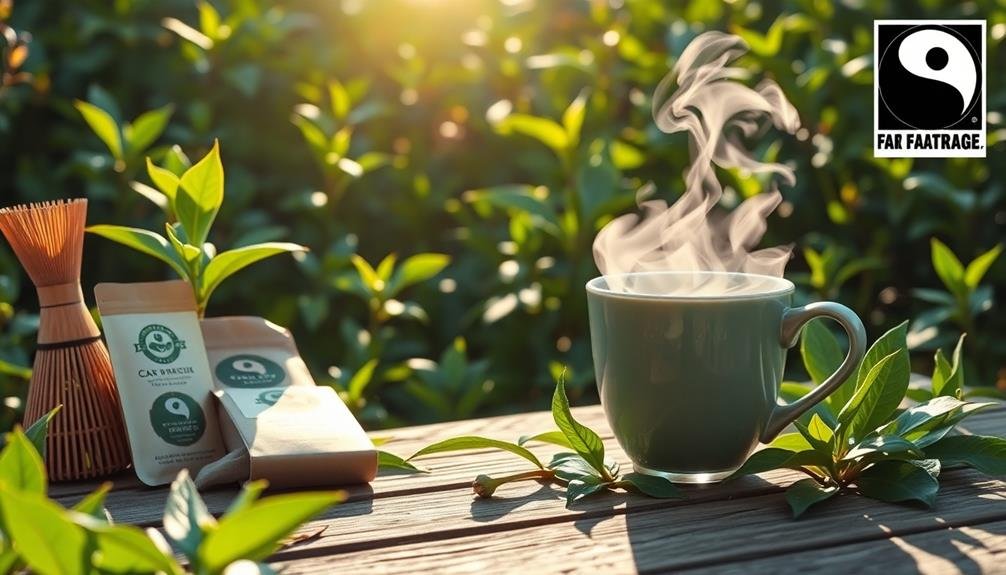
Mindful tea sourcing forms the foundation of any earth-friendly tea ritual. When selecting your teas, prioritize organic options to support sustainable farming practices and reduce pesticide use.
Look for fair trade certifications, ensuring that tea farmers receive fair wages and work in safe conditions.
Consider the origin of your tea and its environmental impact. Choose locally sourced teas when possible to reduce transportation emissions. If you're opting for exotic blends, research companies that prioritize sustainable shipping methods.
Pay attention to packaging. Seek out brands that use minimal, recyclable, or compostable packaging. Loose leaf teas often come with less waste than individually wrapped tea bags. If you prefer bagged teas, look for those made with biodegradable materials and avoid plastic-based sachets.
Don't overlook the importance of water in your tea ritual. Use filtered tap water instead of bottled water to reduce plastic waste. If you're heating water, only boil what you need to conserve energy.
Frequently Asked Questions
How Does the Caffeine Content in Tea Affect Mindfulness Practices?
Caffeine in tea can impact your mindfulness practice. It'll heighten alertness, potentially enhancing focus during meditation. However, it might also increase anxiety or restlessness. You'll need to find your personal balance for ideal mindfulness results.
Can I Use Electric Kettles for Eco-Friendly Tea Brewing?
You can definitely use electric kettles for eco-friendly tea brewing. They're efficient, consuming less energy than stovetops. Choose models with automatic shut-off features to save power. For extra sustainability, opt for kettles made from recyclable materials.
What Are the Best Tea Varieties for Promoting Relaxation and Focus?
You'll find chamomile, lavender, and valerian root teas excellent for relaxation. For focus, try green tea, matcha, or peppermint. Lemon balm and passionflower can help with both. Experiment to see which works best for you.
How Can I Incorporate Tea Rituals Into a Busy Daily Schedule?
You can easily incorporate tea rituals into your busy day. Set aside brief moments for mindful brewing and sipping. Start your morning with a calming cup, take an afternoon tea break, or unwind with an evening herbal blend.
Are There Any Health Risks Associated With Drinking Large Quantities of Tea?
While tea's generally healthy, drinking excessive amounts can have risks. You might experience caffeine-related issues like insomnia or anxiety. It can also interfere with iron absorption and, in rare cases, lead to kidney stones. Moderation's key.
In Summary
You've discovered seven eco-conscious ways to elevate your tea experience. By implementing these rituals, you're not just sipping tea; you're embracing sustainability. From composting to solar brewing, you're reducing waste and energy consumption. Your mindful approach extends to reusable tools, loose leaf practices, and creative upcycling. Remember, every cup you brew mindfully contributes to a greener planet. So, steep on, knowing you're part of a larger movement towards earth-friendly tea enjoyment.

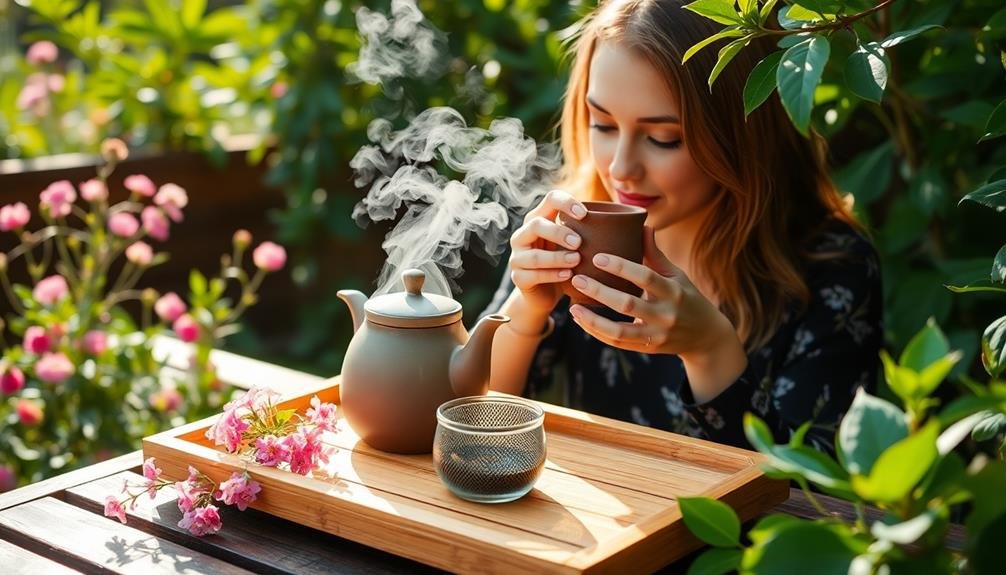
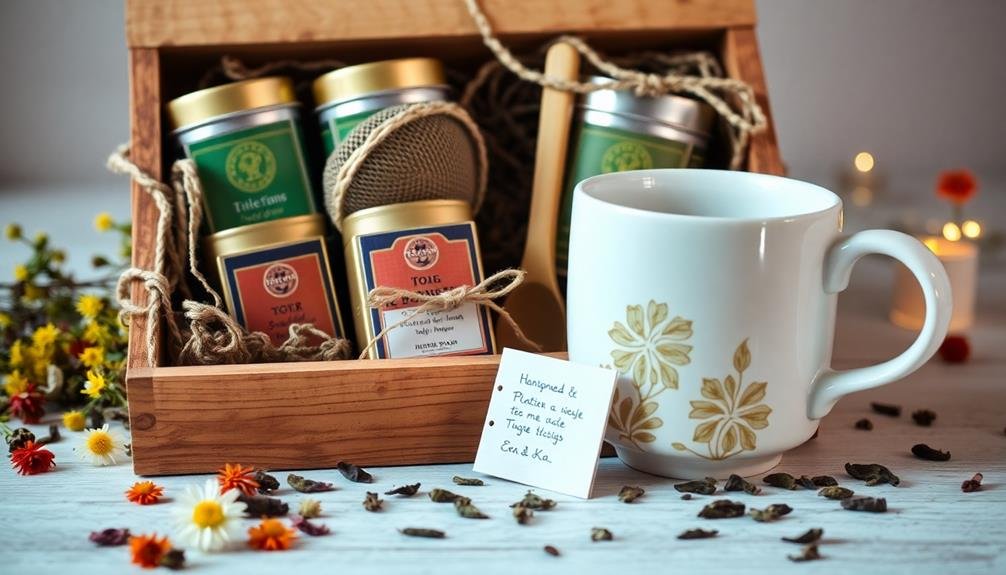

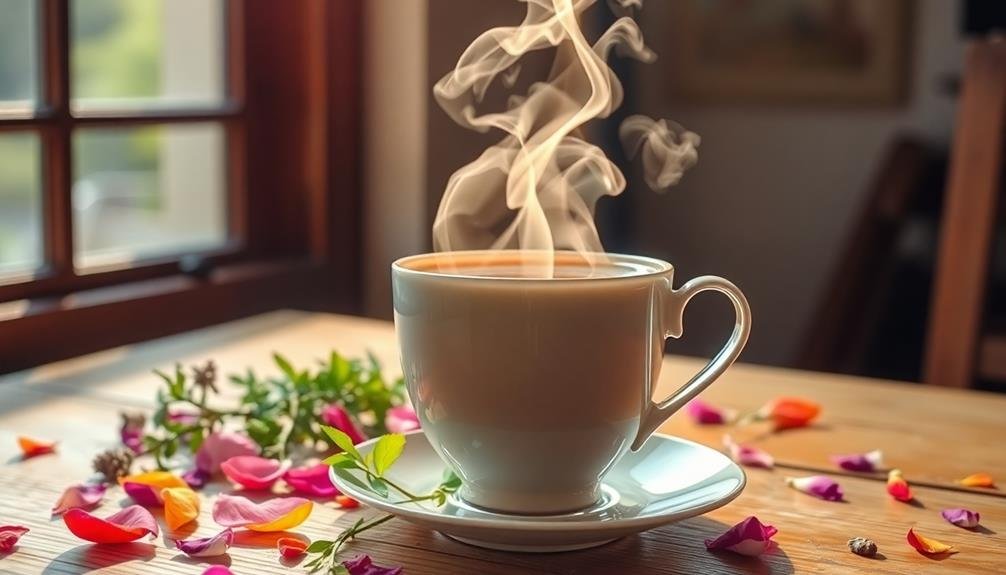
Leave a Reply